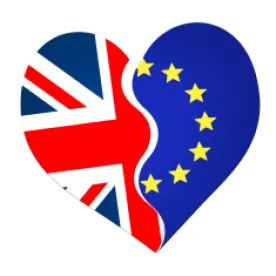As we mentioned in our previous reports (here and here), “sufficient progress” in the first phase of the Brexit negotiation could not be achieved before the European Council of October 19-20, 2017 – so the heads of government decided to wait until their next meeting, on December 14-15, to assess whether the second phase, dealing with the future relationship, could be launched.
By the end of November, the UK government made progress on the sensitive issue of the financial settlement, but it took a frantic week of high political drama to finally reach the “sufficient” agreement, just in time (see our post here on her abortive lunch with President Juncker, and the agreement that was reached following objections from Northern Ireland). British Prime Minister Theresa May was warmly applauded by her 27 EU colleagues when the decision to launch the second phase was made by the European Council on December 14.
The second phase will start formally in February 2018 with a discussion on the “transition period” between the day of withdrawal and the entering into force of the new treaty. To that end, the European Council adopted guidelines in December (here), and on January 29, the Council of Ministers agreed a new mandate for the Commission negotiator Michel Barnier (here).
The discussion on the future relationship itself will only start later in spring. The talks will initially concentrate on a political declaration on the framework of this future relationship, which will be attached to the withdrawal treaty.
The Second Phase of the Brexit Negotiations
As is now well-known, the logic for the two-phase approach in the Brexit negotiation stems from Article 50 of the EU treaty. The withdrawal treaty is a specific instrument which should be agreed upon by qualified majority within 2 years after the procedure has started under Article 50. However, it must take account of the future trade relationship between the remaining EU Member States and the country leaving the EU. The negotiation on the future relationship, however, will take more time, and will be conducted based on the model of trade negotiations between the EU and third countries, which at the end of the process requires the agreement of all EU Member States, ratified by national parliaments.
The EU therefore split the negotiation of these issues in the separation that posed the greatest political difficulty off into the first phase, with negotiations on the framework for the future trade relationship only beginning in phase two. The end of the first phase, however, does not mean that the negotiation over the past is over. Numerous technical issues still need to be addressed and the December joint report (see here) will need to be translated into a legal instrument that will form the basis of the withdrawal treaty. The European Council was careful enough to state in the guidelines adopted in its December meeting that “negotiations in the second phase can only progress as long as all commitments undertaken during the first phase are respected in full and translated in legal terms as soon as possible”.
The Transition Period
The need for a transition period after the UK leaves the Union on March 31, 2019, was accepted early on by both sides – though the political presentation of what will happen during that period is not exactly the same.
In her speech in Florence in September 2017, Prime Minister Theresa May took the initiative: insisting that the UK would leave on 29th March 2019, she mentioned an “implementation period” during which “access to one another’s markets should continue on current terms”. As for its duration, she suggested “around two years”.
In its December 15 guidelines, the European Council agreed to seek a transition that is “clearly defined and precisely limited in time”, but insisted very clearly that, during this period, the UK will remain in the internal market and the customs union, and will have to respect the Four Freedoms (including the free movement of people), that the jurisdiction of the CJEU will continue to apply, and that the UK will be bound by all new EU acquis agreed during the period. Furthermore, as a non-EU Member State, the UK will no longer have a say in the formulation of this acquis. Finally, as the UK remains in the customs union, is still bound by any existing EU free trade agreements, and cannot become bound by new trade treaties unless it gets the EU’s permission to do so.
These conditions were not easily swallowed by the leavers in London, impatient to limit immigration, negotiate trade deals with third countries, and get rid of the CJEU.
The negotiating mandate is silent on a number of sensitive issues where the EU negotiators will be open to pragmatic solutions: for example, trade negotiations with third countries could be initiated, but not concluded without EU agreement; special consultations will take place to discuss fishing quotas; etc.
There is another worry that the British will address during the negotiation: what about the acquis agreed upon during the transition period, which will be applicable to the UK, without the UK having participated in its formation? The UK negotiators have already asked informally for a “good faith” provision to be included in the transition part of the withdrawal treaty. But this too is unlikely to meet the concerns of the “hard Brexiters”.
The EU side answers by advancing the concept of “sincere co-operation”, mentioned in the EU treaties – but some pro-Brexit politicians, such as Conservative MP (and chair of the influential European Research Group within the party) Jacob Rees-Mogg, see this as insufficient, and complain that the UK will become a “vassal state” during the transition period. The January 29 mandate does provide for the presence of the UK in some EU meetings during the transition – as is already the case, for instance, in meetings dealing with Schengen-related issues, where the non-EU members of that agreement participate (without voting rights).
As regards the timing of the transition period, the mandate states that it should not last beyond December 31, 2020. This duration is shorter than the one proposed by Theresa May, but this date was chosen because it coincides with the ending of the current multi-annual financial framework. Until then, the UK is bound by commitments resulting from its participation in the framework. But it would be much more complicated to calculate financial contributions afterwards, since there is no question of associating the UK to the negotiation of the new framework for the period 2020-2025: already now, some in London blame the EU for intending to have the UK “pay for access” to the EU market and its programs.
Giving evidence in mid-January to MPs on the House of Commons Exiting the European Union Committee, Brexit Secretary David Davis said that it might be “more sensible” to end the transition in March 2021, to fit in with the “grace period” the UK intends to grant EU citizens living in the UK, noting that the European Commission is aiming for the transition to end in December 2020. However, he also said the precise duration of the transition would not be a “deal breaker”, and that the two sides would settle on a period of “21 to 27 months”.
Since the main reason for the transition period was to avoid Britain falling from the “cliff edge” the day after Brexit and to allow more time to conclude the agreement on the new relationship and have it ratified by the Member States – the simplest solution would be not to mention any date for the end of the transition period. But this option has already been tarnished by the internal political debate in the UK, some speculating that, were this the case, the transition could continue indefinitely – or at least until new elections or a new referendum, allowing the UK to reverse the Brexit process.
Differing Approaches to Trade Treaties
Trade is a subject particularly close to the hearts of the “hard Brexiteers.” Much though internal UK analyses give the UK lower growth outside the EU no matter what agreement is reached (see here), the International Trade Secretary, for example, sees Brexit as an opportunity for the UK to be “an evangelist for world trade” (see here). The proponents of Brexit are anxious to get new trade deals in place.
However, the EU and the UK have rather different views on how to handle the question of new trade agreements. The UK considers that it should be able to negotiate and conclude trade deals during the transitional period. Conversely, as outlined above, the EU’s position is that the UK remains bound by the existing EU trade agreements until the end of the transitional period. This means that the UK can negotiate with future trade partners, but cannot conclude any agreements until after the transitional period. In any case, it is difficult to see which serious partners would agree a trade treaty with the UK, while its final relationship with the EU and its access to the EU market remain unclear.
As to existing EU trade agreements, the UK (and the EU) hope to “roll these over.” This could be done in one of two ways, both of which would require the agreement of the relevant trade partner. They might seek to convert existing EU trade deals into tripartite agreements. Alternatively, the existing EU deals would remain bilateral and the UK would enter its own bilateral agreement on the same terms as the existing EU deal, but apportioning the current market access as between the UK and the EU27. Both scenarios face challenges.
If it follows the “tripartite option”, the UK would theoretically have to remain within the EU single market and Customs Union, so that any agreed tariffs and tariff-rate quotas (“TRQs”) would continue to apply to the EU and UK collectively. However, the UK has made it very clear that it intends to leave both the single market and the Customs Union, rendering this option both unlikely and impractical.
As for the “separate agreement option”, the UK would need to negotiate its own tariffs and TRQs with each trading partner individually. Consequently, the EU and its trading partners would likely also wish to renegotiate the existing tariffs and TRQs, which are of based on the current EU market – and, as preferential agreements, these are subject to complex and extensive negotiations that usually take many years to complete. Indeed, a similar issue has already arisen in the context of the joint EU-UK proposal to replicate the EU’s existing Schedule of Concessions as annexed to the WTO’s General Agreement on Tariffs and Trade (“GATT”), where it has already been rejected by seven major food exporting countries (see further our post of October 27, 2017, here).
The New Relationship
Even if it has made headlines in the British press since the Brexit referendum, the new relationship the UK wants to develop with the remaining Member States of the EU has not yet been defined clearly, except negatively, by the drawing of “red lines”.
The most important British red line is included in the letter Theresa May sent to the President of the European Council, Donald Tusk, when launching the Brexit process. In her description of the “deep and special partnership” she wants with the EUfor the future, the British Prime Minister states clearly that the UK does not seek membership of the single market. She adds that “we understand and respect your position that the Four Freedoms of the single market are indivisible and there can be no ‘cherry picking’. […] We know that we will lose influence over the rules that affect the European economy. We also know that UK companies will, as they trade within the EU, have to align with rules agreed by institutions of which we are no longer a part – just as UK companies do in other overseas markets.”
The official British position has not deviated from this approach until now, and it is on that basis that the EU is currently preparing new guidelines for this part of the negotiation, which should start in spring.
But with time, the negative implications of this red line become ever clearer and feed an animated debate in the UK on the exceptions that might be asked for. The most active debate takes place in the City of London, where there are struggles to convince the government either to renounce to having the UK leave the internal market, or start as early as possible to negotiate a regime of “equivalence” of the standards on both sides, which would allow London to continue to handle Euro-related services.
The leavers are impatient to start negotiating trade deals with third countries, but no real solution has yet been found to make these compatible with the suppression of controls at the border with Ireland.
There is already heavy pressure for the UK to continue to participate in the EU research program aviation security bodies, life sciences regulations, etc. A special relationship will probably need to be established in the area of Foreign and Security policy, in which the withdrawal of the UK would seriously weaken the European position. Since this area is not submitted to the community method, a special association might be easier to define.
But no clear positions have yet been agreed on these issues, and even if the negotiation can start in April, the clock is ticking. Yet the government seems to have forgotten the nature of trade negotiations – that the larger partner can broadly set the terms of the negotiation. In this case, this means the EU can determine what they are willing to offer the UK, no matter its “red lines” – and the UK can take or leave them. In this context, even a political declaration on the framework for the future relationship will be hard to draft in the remaining months before the withdrawal treaty deadline.
Trouble Ahead in the UK
As the clock ticks towards May 2019, and the “future relationship” negotiations begin, constructive ambiguity will only get the UK government so far. UK Ministers will be forced to outline, bit by bit, exactly what future relationship they seek with the EU.
As they do so, they will come under heavy fire from both sides of the UK House of Commons. This will put Theresa May’s government under significant strain. As she lacks the authority – and the parliamentary majority – to hold the hard Brexiteers in check, attacks on the government’s position from its own side will increase. There was a taste of this in last Thursday’s conflicting statements on the UK’s aims for the transition period – from the Chancellor, Philip Hammond, and from the aforementioned informal leader of the hard Brexiteers, Jacob Rees-Mogg MP. The Chancellor, speaking at the World Economic Forum meeting at Davos, outlined his vision of Brexit as “two completely interconnected and aligned economies with high levels of trade between them, and selectively moving them, hopefully very modestly, apart”. Rees-Mogg, on the other hand, called for the Government to “fundamentally change” its tone on Brexit, not accepting close regulatory alignment with the EU, but rather working to secure “hope and opportunity”.
As these disagreements intensify, they put the Prime Minister in a difficult position, and raise the specter of at least a Conservative leadership contest – or possibly even another general election – before the UK leaves the EU. However, it is not clear what effect either of these contests would have on the shape of Brexit, other than delaying negotiations. Any Conservative government would have difficulty facing down internal proponents on a hard Brexit; and the main opposition Labour Party’s leader, Jeremy Corbyn, is a life-long Eurosceptic, and has repeatedly stated that he would take the UK out of the single market and the customs union – thus facing the same difficulties as the current government’s approach.






 />i
/>i

